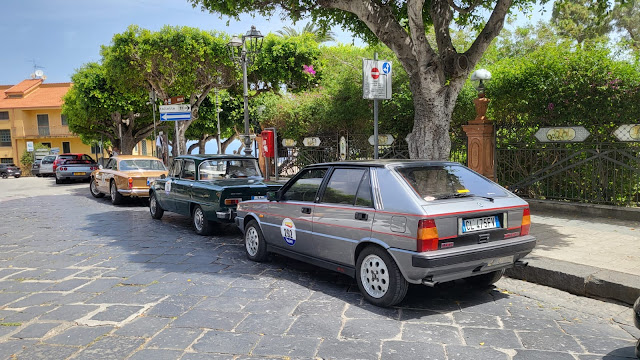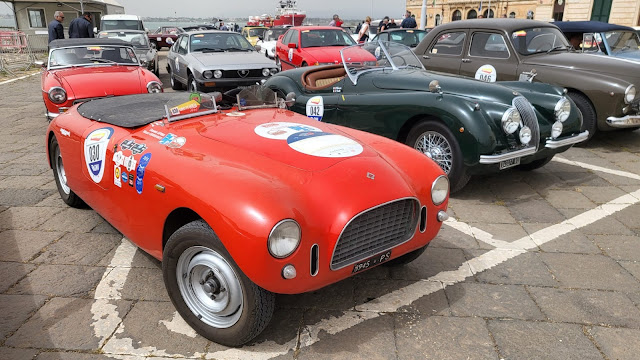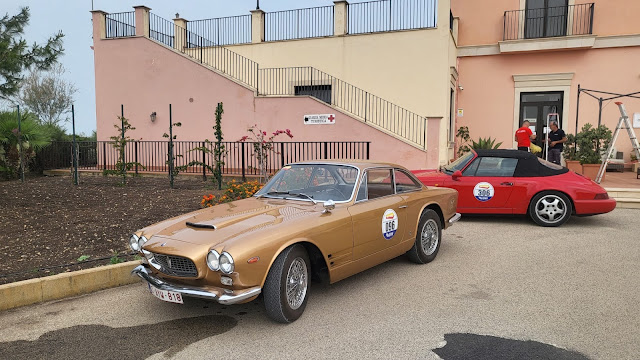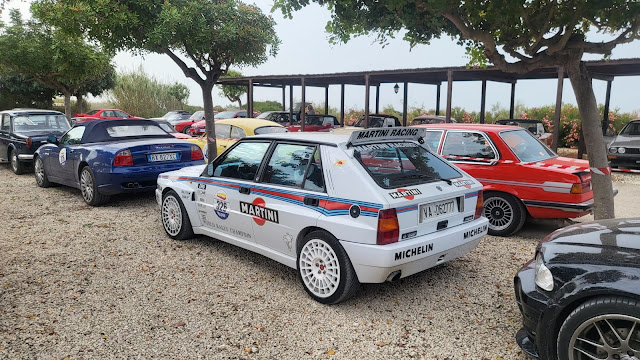May's Giro de Sicilia shared the name of a bike race, but instead honored the tradition of the Targa Florio, the road race last held in 1973 in the mountains near the capital city of Palermo, in an event covering 5 days full of dramatic countryside, townscapes, and food. Lancias showed up in what would count as big numbers here in the US. Though the company was famous for unit construction after pioneering it with the Lambda in 1922, they also offered bare chassis as the basis for custom coachwork by the likes of Pinin Farina on the V8 Astura, and by Viotti on the small V4 Augusta and bigger V4 Artena, including trasformabile sedans in the late 30s with full-length fabric sunroofs. Lacking the entry list, we couldn't be sure who built the streamlined body of the sunroof sedan above.

In shots above and below, the cars gather in the civic space fronting the Palermo Opera House. Below is another Lancia, this time a sedan with elegant aerodynamic bodywork. By the late Thirties, Pinin Farina was offering similar streamlined contours on the V8 Astura chassis and these also replaced the traditional Lancia radiators with streamlined prows.


Here another Lancia, a Pininfarina-bodied Flavia coupe introduced in 1962, rests next to an Alfa Romeo Duetto introduced 4 years later, also a PF design. The boxer four was new in 1959, and a departure from the narrow-angle V configurations of previous Lancias. Front-wheel drive was also new to Lancia. The first coupes were 1.5 liters, and 1.8 liter engines followed in '63, with a fuel injection option in '65. Typical of Lancia engineering eccentricity, the car featured twin cams, but not the overhead type...
Our photography* crew's modern (late 20th century) Lancia Delta parks behind their Alfa Romeo Giulia sedan, a design first appearing in 1962, in a charming seaside town east of Palermo: San Stefano de Camastra.
Above, the Giulia at the starting line near the Palermo Opera House. Below, a Fiat-based etceterini from the early Fifties, with forward-leaning grille perhaps inspired by Michelotti's Ferrari designs for Vignale. Engine type is unlisted, but a Fiat 1100 would be a good guess. Neighbors include a Jaguar XK120 and an Alfa 1900 sedan from the early Fifties, Alfa Romeo's first mass-produced car...
A Vignale-bodied Maserati Sebring Series 1, built from 1962-'65 on a shortened 3500GT chassis, was the most popular of the Sebring line, with 348 built. The Series 2, built in '65 and '66, featured quad headlights in two oval mountings and more pronounced fender vents, with the last run of 98 built featuring the 4.0 liter twin-cam, twin-plug alloy inline six. Early Series 1 cars came with the 3.5 liter engine, while later ones were fitted with the 3.7. Because Sebrings are scarce compared to other production Maseratis, body and trim parts can be a problem...
Below the low-mounted Sebring Series 1 fender vents are shown; Series 2 positioned the vents higher. The 964 Series Porsche behind it (1989-'95) is a reminder that more modern cars were invited to participate in the Giro de Sicilia...
What appears to be a Mercedes 170S cabriolet from the 1949-'55 period joins a 21st century Porsche...
That Giulia again, this time parked at the nicely restored, still operational headquarters of the Civil Guard (the famous carabinieri) in Siracusa...
This 1927 Fiat photographed in Ortigia endured to cover the whole event, while none of the other pre-war (or inter-war) cars managed to go the distance.
The first BMW 3 Series appeared in summer of 1975 (whew, almost 5 decades ago) and continued in production into December 1983. The graphic pattern on the flanks may mean this is an Alpina version...
A Lancia Delta Integrale Evo reminds us of Lancia's 15 World Rally Championships, the most of any make. These began with the front-drive Fulvia HF in 1972, continued with the mid-engined Stratos in '74 through '76, and built an aura of invincibility with Championships won by the Integrale, an AWD derivative of the front-drive Delta, every WRC from 1987 through 1992.
The Selinunte Archaeological Park, located between two rivers, the Modione-Selino and the Cottone, preserves the ruins of several temples built starting around 628 BC. It's known today as the Acropolis of Sicily...
The Lamborghini Urraco S below was a bit more recent, designed for Bertone by Marcello Gandini with transverse mid-mounted lightweight V8 chassis by Gianpaolo Dallara, with perhaps an even more harmonious form than the Ferrari Dino 308GT4 from the same era, also by Bertone. The public bought more of the GT4, though, and only 791 Urracos found homes from 1972-'79. Here the Lambo is flanked by a Vignale-bodied Lancia Flavia cabriolet on the left, and an early version of the Fiat 1100 sedan (1953-'69) on the right, parked in front of that carabinieri HQ in Siracusa.
Below, a parting shot of that famous mountainous countryside, for anyone mulling participation in next year's event...




























